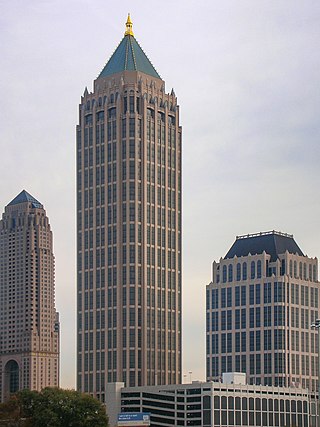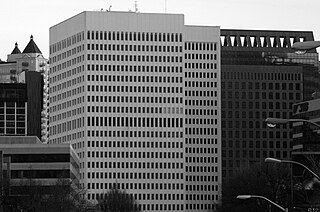
Bank of America Plaza is a supertall skyscraper between Midtown Atlanta and Downtown Atlanta. At 311.8 m (1,023 ft), as of February 2024 the tower is the 23rd tallest building in the United States, the tallest building in the Southeastern region of the United States, and the tallest building in any U.S. state capital, overtaking the 250 m (820 ft), 50-story One Atlantic Center in height, which held the record as Georgia's tallest building. It has 55 stories of office space and was completed in 1992, when it was called NationsBank Plaza. Originally intended to be the headquarters for Citizens & Southern National Bank, it became NationsBank's property following its formation in the 1991 hostile takeover of C&S/Sovran by NCNB.

One Atlantic Center, also known as IBM Tower, is a skyscraper located in Midtown Atlanta, Georgia. It is the third tallest building in Atlanta.

The Westin Peachtree Plaza, Atlanta, is a skyscraper hotel on Peachtree Street in downtown Atlanta, Georgia, adjacent to the Peachtree Center complex and the former Davison's/Macy's flagship store with 1,073 rooms. At 723.0 ft (220.37 m) and 73 stories, a total building area of 1,196,240 sq ft (111,134 m2) and a 187 ft (57 m) diameter, the tower is the fourth-tallest hotel in the Western Hemisphere, and the 30th tallest all-hotel building in the world.

Georgia-Pacific Center is a 212.45 m (697.0 ft), 1,567,011 sq.ft skyscraper in downtown Atlanta, Georgia, United States. It contains 52 stories of office space and was finished in 1982. Before the six-year era of tall skyscrapers to be built in Atlanta, it was Atlanta's second-tallest building from 1982 to 1987. It has a stair-like design that staggers down to the ground, and is clad in pink granite quarried from Marble Falls, Texas.

The State of Georgia Building is a 44-story, 566 feet (173 m) skyscraper located in downtown Atlanta, Georgia, U.S. Built in 1966, the building was the tallest building in the Southeast at the time. It was Atlanta's tallest until 1976, when the Westin Peachtree Plaza surpassed it. It was built on the site of the Peachtree Arcade, A. Ten Eyck Brown's 1917 covered shopping arcade which connected Peachtree and Broad streets. 2 Peachtree Street was originally constructed as the new headquarters building for First National Bank of Atlanta, also known as First Atlanta, replacing its older (1905) headquarters building next door. It was designed by a partnership of Atlanta architectural firm FABRAP and New York firm Emery Roth & Sons. First Atlanta was acquired by the holding company for Wachovia Bank in 1985, but continued to operate under its own charter until 1991. In 1991, under new liberalized banking laws, First Atlanta was merged into the charter of Wachovia Bank of Georgia. Shortly thereafter, Wachovia moved its Georgia offices to 191 Peachtree and 2 Peachtree Street was acquired by the state of Georgia for government offices.

Peachtree Center is a district located in Downtown Atlanta, Georgia. Most of the structures that make up the district were designed by Atlanta architect John C. Portman Jr. A defining feature of the Peachtree Center is a network of enclosed pedestrian sky bridges suspended above the street-level, which have garnered criticism for discouraging pedestrian street life. The district is served by the Peachtree Center MARTA station, providing access to rapid transit.

Hancock Whitney Center, formerly One Shell Square, is a 51-story, 697-foot (212 m) skyscraper designed in the International style by Skidmore, Owings and Merrill, located at 701 Poydras Street in the Central Business District of New Orleans, Louisiana. It is the tallest building in both the city of New Orleans and the state of Louisiana, and is taller than Louisiana's tallest peak, Driskill Mountain. The building is primarily used for leasable office space, with some retail space on the ground level.

The Hyatt Regency Atlanta is a business hotel located on Peachtree Street in downtown Atlanta, Georgia. Opened in 1967 as the Regency Hyatt House, John C. Portman Jr.'s revolutionary 22-story atrium design for the hotel has influenced hotel design enormously in the years since. The hotel instantly became one of the most recognized buildings in Atlanta.

Colony Square is a mixed-use development and sub-district in Midtown Atlanta, Georgia, located on Peachtree Street in between 14th and 15th Streets. The oldest high-rise development in Midtown, the sub-district was built between 1969 and 1975, with Henri Jova of Jova/Daniels/Busby serving as principal architect. It was the first mixed-use development in the Southeast.
Smallwood is an American architectural firm based in Atlanta, Georgia. Established in 1979, the company has approximately 108 total employees across all of its locations and generates $25.00 million in sales (USD). There are 2 companies in the Smallwood, Reynolds, Stewart, Stewart & Associates, Inc. corporate family; with the Atlanta office serving the United States and international clients with an additional office in Singapore. Its Atlanta office is headed by eleven principal architects, many of whom are members of the American Institute of Architects (AIA) and are Leadership in Energy and Environmental Design (LEED) Certified Professionals. The firm has worked on designs in corporate, commercial, hospitality, multifamily, industrial, governmental, and educational settings.

999 Peachtree is a high-rise class A office building in midtown Atlanta, Georgia. Built in 1987 by Heery Architects and Engineers, the building is situated on the Midtown Mile, at the intersection of Peachtree Street and Tenth Street.






















